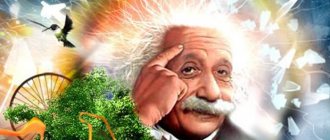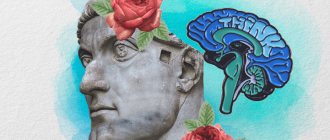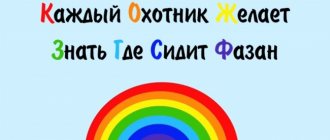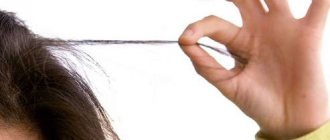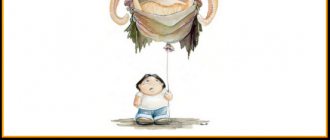Sometimes you can hear about a person: “He is completely devoid of imagination!” Basically they say this about people who don’t know how to fantasize. But is the development of fantasy and imagination really necessary for modern man? Scientists claim that imagination is as important a mental process as thinking, memory, and attention. Without it, there will be no great discoveries and works of genius, inventions necessary for humanity. Life itself will become boring and dull without imagination.
Imagination expands the possibilities of cognition and transformation of the world around us
What is imagination for?
Imagination is a mental process necessary to create new images based on existing ideas. Is it really necessary for everyone? Maybe we should leave it to artists, designers, inventors and other people called upon to create new images?
According to psychologists, none of the intelligent beings can do without imagination, since it sets thoughts in motion, helps to go beyond the present and comprehend the future, awakens feelings, and contributes to the making of plans. It originated in the process of labor on the basis of thinking and memory, which means it works in inextricable connection with them. Without imagination, the entire human psyche will become impoverished.
Interesting. A synonym for imagination is fantasy, this action is known to everyone. Fantasy accompanies a person’s childhood, making it memorable and not boring. All types of children's activities are associated with imagination.
Features of creative imagination
Creative imagination is a type of thinking in which a person creates new objects or images that have value for humanity. They appear as a result of memory processing by consciousness and with the help of other psychological mechanisms.
Creative development is a necessary part of personality development. This is not just a labor-intensive process that represents a certain value. There are many types of creative activities that require imagination.
Ways to develop imagination
Mnemonics for memory development for adults and children - methods and techniques
The activity of imagination is most evident in younger children and adolescents who are learning about the world around them. Some of its aspects are sometimes not understandable in reality, so imagination comes to the rescue, for example, how to imagine the Universe, other worlds, extinct animals, the life of ancient people. Psychologists say that if preschool children have a rich imagination, then the cognizable world will be more diverse for them.
What about adults, is their imagination really more meager? Many experts assure that every adult can and should think about how to develop imagination, since work, study, and life circumstances sometimes require non-standard solutions.
Using effective methods you can develop your creative imagination
Psychology knows effective ways to develop imagination:
- Visualization is the simplest action, which consists of mentally reproducing a certain object in detail. To master this technique, it is better to start with easy and pleasant playback. For example, at work, imagine a cozy evening with a cup of coffee, imagine every detail, remember the aroma, taste, connecting as many senses as possible. In this way, different events can be reproduced. If you have difficulty visualizing real events, you can use incidents from books.
- Association is a classic that can be found in any logic textbook. The essence of the technique is to select others for a given image that are associated with it, that is, connected. For example, the word “vacation”, you need to select all the words for it that will enrich it: train, plane, trip, suitcase, sea, seagulls, sun, beach, sand, excursion. The more images are selected, the better the imagination develops. The peak of development can be a situation when not only real, but also abstract concepts are combined. For example, sad, cheerful, life, beauty.
- Creativity is a fun way for the imagination to work. It is human nature to create, to create beauty in the environment. In modern life, this technique is known as a hobby. You can come up with unique things: paintings, new fashions, designer interiors, works and much more, without which human life is impossible. If you don’t have enough ideas for inspiration, you need to go where there are plenty of them: an art gallery, an exhibition of contemporary art, unique objects. It all depends on what a person wants to do.
- Play is the simplest and most exciting way to develop imagination. Currently, various educational games, the essence of which is the creative control of a character or action, are becoming popular among adults and children: “Imaginarium”, “Da Vinci’s Riddles”, “Tetris” and many others.
Games and creative activities help to imagine and fantasize
In adults
It’s not for nothing that they say that an adult remains a child at heart, so it is possible to use all the techniques that are usually used in relation to children. Playful and creative activities may have a different meaning, but they will delight adults no less. Psychology websites offer a variety of imaginative games that people can incorporate into their daily lives. Moreover, you don’t need to find extra time in your busy work schedule to play. You can play on the way to work and home, in a traffic jam, on vacation, when meeting with friends. The most popular:
- Doodles (English doodle - scribbles, riddle - riddle) are abstract images in which you need to see images of some objects. With a good imagination, you can see several images in one picture. There are no right or wrong answers to the task, the main thing is an original solution.
- “Burime” (French bouts-rimés – “rhymed ends”) is a literary game, the main rule of which is the composition of comic quatrains on a given topic. It’s better to take unexpected and strange rhymes, which will help strain your brain, fantasize, and come up with humorous continuations. To begin with, rhymes from any poem will be useful, for example, rays of streams, snow of meadows.
- Creative hobbies, such as knitting, sewing dolls, embroidering pictures, drawing, weaving, bead paintings, puzzles and much more, help improve imagination. The main thing is to find time for your favorite activities, where you can give free rein to your imagination.
A person needs to find time and opportunities to work on improving his imagination
In children and adolescents
Creative play tasks are good for developing children's imagination. The main goal is to fantasize based on creating new images from the proposed elements:
- In practice, the classic exercise “Blots” is often used, which will interest not only the baby, but also the school-age child. No special preparations are required. Take a sheet of paper, fold it in half, and apply a drop of liquid paint to the middle of the fold. You need to iron the fold and unfold it again. Consider the resulting blots, imagine what it could be? It is useful to organize a competition for the most non-standard solution.
- The development of imagination is facilitated by tasks on the topic “Imagine and complete the drawing.” The cycle of such exercises includes drawing unfinished contours, which is useful for creative imagination.
- Outdoor games are good for developing imagination for any year of life, starting from preschool age. They are especially useful in families with children of different ages. For example, the elder throws a ball with a word, the child must return it with a word denoting a new image of the same object. The funnier the new image, the more interest in the exercise. For example, a writing pen, a reading book, walking shoes, a carrying bag. The one who comes up with the most funny images wins.
Development of spatial thinking and imagination through play
A selection of exciting board games for developing spatial imagination and thinking in preschoolers and school-age children.
Magnetic game Noah's Ark
To develop spatial imagination, I can recommend the magnetic game Noah's Ark from Bondibon. This is a puzzle in which you need to help the animals take places on the ark using task cards.
Board Game Color Code
Game flow Color code: Choose a challenge from the 100 suggested and recreate the shape by placing transparent plates on the colored shapes.
It will be necessary not only to use the correct plates, but also to orient them correctly and place them in the correct order.
Board game "Quadrigami"
A puzzle that's both Rubik's cube and Japanese origami: fit each puzzle into a 4x4 square, with one side completely white and the other completely black. For children over 10 years old.
Board game Antivirus
Rules of the Anti-Virus game: place the starting pieces as indicated in the task and remove the red virus from the board by moving the pieces diagonally; 60 tests of 5 difficulty levels.
Ice cream express game Go Go Gelato
The development of logic, the ability to manipulate objects and imagination in the board game Go Go Gelato occurs during the assembly of ice cream according to instructions on the cards.
Game Assemble and disassemble at the circus
A very interesting game from Ravensburger. Find the arrangement of color blocks and animals and reproduce the model. Developed spatial arrangement, skill and speed of play are required.
Board game Blue Orange Top That!
Top That game flow: Collect mage items and use logic, skill and speed. According to the instructions on the cards, certain items must be present but hidden.
Board game Picmix
Observe, shuffle and orient your cards to get the right combination in the game Pikmix. The board game Picmix trains attentiveness and reaction speed.
Game Speed Caps
A board game from Bondibon for manual dexterity and visual acuity. Promotes the development of spatial imagination and thinking, hand-eye coordination, concentration and visual perception.
Collect the caps as quickly as possible in the order indicated on the task cards and press the bell. In each round, players compete to see who will complete the task correctly and collect the most cards.
Game Traffic Jams
A very budget-friendly and topical board game for developing spatial imagination. Also develops your children's fine motor skills, manual dexterity, color recognition, artistic sense, imagination and sorting ability, thinking, planning skills.
Link to the game on Aliexpress.
Logic game IQ-Element
The essence of the game is to place all the details on the playing field so that the surface is smooth, without protruding elements. A total of 120 tasks, 5 difficulty levels.
Similar games: IQ-Genius Companion, IQ-HoHo, IQ-Twist, IQ-Block, IQ-Focus, IQ-Rings. All IQ logic games Smartgames.
Board game Doctor Eureka
Fill the test tubes with substances in the correct order, and if you are faster than other players, you can become the greatest scientist of all time. Link to the game Doctor Eureka.
Simple exercises to train your imagination
Development of thinking in an adult and a child - recommendations
Psychologists offer many simple but effective exercises for developing thinking and flights of imagination that are suitable for people of all ages. Their main advantages are simplicity and accessibility. Everyone is able to find in the flow of information the exercise that will appeal to a particular person. For example:
- Counting in your head is accessible and interesting to everyone who has school knowledge. There is no need to use any notes, just count mentally. The exercise is especially useful for those who are good at mathematics. You can fantasize about geometric shapes, mentally building all sorts of combinations from them.
- Paradoxically, you can watch children's cartoons with your child and use them as a workout for your mind and imagination. It's helpful to watch them without sound and then come up with funny dialogue. The funnier the better for the imagination.
- The simplest way relates to the world of books. Reading detective stories or fantasy is becoming fashionable; it will benefit both imagination and fantasy.
- “Nonsense piggy bank”, where you can put interesting things: thoughts, pictures, ditties, jokes - everything that is considered nonsense. If necessary, you can always get an idea for a creative solution from there.
- Collective games are becoming fashionable, then it’s time to get some old-time fun out of the box. For example, "Pantomime", in which players must guess what action is being depicted. Creative imagination develops based on memory, since you need to remember what picture the participants are depicting.
Simple exercises will help your imagination fly
Exercises to develop imagination during a creative crisis
Lack of imagination often worries creative individuals who, by their vocation, are forced to constantly work with imagination. Here are a few exercises that will help you discover your writing talent or train your imagination:
- Take a pen or pencil and colorfully describe the place where you like to relax.
- Imagine that an unexpected guest came to you at 4 o'clock in the morning. What will you tell him? Write it down on paper.
- Write a short story on a philosophical topic, for example, what is the meaning of life?
- Create a message for your future self. Contact yourself in 10 years, ask or give advice, tell about yourself and try to guess what you will do in the future.
- Find 250 things to do if you had an extra week.
Developing imagination for creativity and drawing
How to develop memory in a child of preschool and school age
Usually, when talking about the formation of imagination in the field of creativity, they mean younger children. But many adults are also not averse to devoting their free time to drawing. Psychologists have proven that the passion for drawing stops such a serious disease as Alzheimer's disease, which has long been associated with the development of intelligence. The lower it is, the greater the chance of getting sick and, conversely, creatively developed people avoid brain disorders. Many people understood this, and a fashion for creative pursuits came into life. How to develop imagination to create unique things?
A short effective course in developing creative imagination:
- manipulations with photographs - take photographs of nature and find familiar images in them;
- following Leonardo da Vinci’s formula “to see images even in wall cracks,” you can use images of stones, wood cuts, shadows of objects;
- books and drawing manuals - will help you get inspired by ideas for creativity, study the manner of drawing in different directions, choose what pleases your soul;
- thematic exhibitions and art galleries - will suggest topics for independent creativity;
- collages, appliqués are an effective way to develop imagination;
- drawings from life, even unsuccessful ones, according to professionals, will help develop creative abilities and give room for imagination.
Drawing and creativity help fight dangerous diseases
Developing creative imagination is the best investment in your mental health; having a rich imagination is a gift from above that prevents life from turning into a boring, gray existence.
Imagination and fantasy in children
Developing imagination in children is a special task that parents must cope with.
After all, in addition to the real world that surrounds us, each person also has his own, where all his dreams and desires are stored. Imagination helps to separate from reality or, on the contrary, embellish it. A synonym for this phenomenon is the word fantasy. Thanks to her, you can come up with something new and interesting, something of your own, which will be based on moments stored in the subconscious. Children’s imagination develops through play and developmental tasks, where, for example, they need to come up with a way out of some situation that cannot be dealt with without imagination. Introducing new and interesting things that you may not even encounter in life allows you to develop yourself and not feel lonely. By coming up with something new, the child gains energy, thanks to which he does not sit still, but develops both physically and morally.
Video
Device for combing cats and dogs Discounted item (No. 66)
665 ₽ More details
Furminator for dogs FURMINATOR S for small short-haired breeds
1739 ₽ More details
Nipple drinkers for rabbits
Game exercises that develop imagination
- Solving doodles. Doodles are simple doodle-like pictures that contain multiple interpretations. The person is asked to say what he sees in the image. Interestingly, there are no right or wrong answers. The process of finding the answer itself is training.
- Word game. The standard game can be complicated by new rules. For example, you need to name only those words whose symbols fit into a five-liter barrel. Or name only those items that are in the house.
- Description of images. A very effective method, especially for children. Show your child any illustration and ask him to tell you what he sees. You will be surprised by the limitless imagination of a little explorer.
- Adults will really enjoy this game. While traveling on the subway or other public transport, try to come up with a biography for any passenger in your mind - first name, last name, year of birth, main moments of life. Guess his occupation and hobby. This game can be a great option for spending time with friends in the park or any other crowded place.
Contents of the exercise
The presenter uses gestures, facial expressions, and sounds to depict some object (train, car, teapot, duck, plane, Christmas tree, ice cream, light bulb, etc.) or some action (washing, combing, drawing, swimming, singing).
The rest of the children in the group must guess what object or action the leader is depicting. The one who guessed the driver's intention becomes the leader. The game continues several times.
Exercise 5. “Draw by dots”
Target.
Develop children's imagination and spatial perception.
Contents of the exercise
Children are given the beginning of a fairy tale or story. Their task is to continue the story and come up with its ending.
Story options:
A) Once upon a time there was a doctor in the countryside. He often went to see sick people in other villages, but he didn’t have a dog in the house. Therefore, he was always worried about his property.
One day the doctor decided to leave an inkwell to guard the house.
Just at this time a thief decided to break into the house. He climbed over the fence, opened the door, and...
B) For the New Year, a beautiful and lush Christmas tree was put up in the house. A bright red star was hung on the top of the forest beauty. The children helped decorate it with colorful balloons, confetti, glass and paper toys. The most interesting thing is that at night all the toys came to life, they could talk, laugh and even run, jump and scream. And so on New Year's Eve, when everyone went to bed, the toys began to move and began to have their own casual conversation about all sorts of nonsense. And suddenly their attention was attracted by an incomprehensible noise in the very corner of the room...
Exercise 3. “Unnecessary object”
Target.
Develop creative thinking and imagination of children.
Development of 3D representations
Three-dimensional (three-dimensional) figures are obtained from flat ones by applying the operations of broaching and drawing rotation. It is assumed that the rotation occurs so quickly that the elements of a flat figure, moving from one position to another, merge into one surface. This surface must be represented and its shape determined.
Rotation figures
1. What shape will you get if you spin an equilateral triangle around a height? (Cone)
2. What figure of rotation is obtained if you spin a rectangle around an axis passing through its middle? (Fig. 39) (Cylinder)
Rice. 39.
3. What figure of rotation is obtained if you spin a square around its diagonal? (Fig. 40). (Double Cone)
Rice. 40
4. What shape will you get if you spin a circle around its diameter? (Fig. 41).(Sphere)
Rice. 41
5. What figure will you get if you spin a circle around an axis lying outside the circle? (Fig. 42) (Thor)
Fig.42.
6. What figure will you get if you rotate the tractrix around a vertical axis? (Fig. 43). (Pseudo-sphere)
Fig.43.
7. What figure will you get if you rotate the tractrix around a horizontal axis? (Fig. 44). (Pseudo-sphere)
Fig.44.
Broach figures
Broaching is the construction of a three-dimensional figure from a flat one by moving it plane-parallel along a guide. It is assumed that all the points through which the figure passes merge and turn into a continuous surface. 1. What figure will be obtained as a result of drawing a circle along a line segment passing through its center, perpendicular to the plane of the circle? (Fig. 45). (Cylinder)
Fig.45.
2. What figure will be obtained as a result of drawing a triangle along a line segment passing through its center, perpendicular to the plane of the triangle? (Fig. 46). (Triangular prism)
Fig.46.
3. What figure will be obtained as a result of drawing a square along a line segment passing through its center perpendicular to the plane of the square? (Fig. 47). (quadrangular prism)
Fig.47.
3. What figure will be obtained by drawing a pentagon along a line segment passing through its center perpendicular to the plane of the square? (Fig. 48) (Pentagonal prism)
Fig.48.
Hood figures
Extraction is a method of constructing a three-dimensional figure from a flat one by stretching its surface. It is assumed that the surface of the figure is capable of stretching like a thin rubber film and each point of inflection of a flat figure leads to the appearance of an edge on a three-dimensional figure. It is assumed that all the points that the figure passes merge and turn into a solid surface.
1. What figure will be obtained as a result of drawing a circle along a line segment passing through its center, perpendicular to the plane of the circle? (Fig. 49). (Cone)
Fig.49.
2. What figure will be obtained as a result of stretching a triangle along a line segment passing through its center, perpendicular to the plane of the triangle? (Fig. 50). (Triangular pyramid)
Fig.50.
3. What figure will be obtained as a result of extending a square along a line segment passing through its center perpendicular to the plane of the square? (Fig. 51). (Quadrangular pyramid)
Fig.51.
4. What figure will be obtained as a result of stretching a pentagon along a line segment passing through its center perpendicular to the plane of the square? (Fig. 52). (Pentagonal pyramid)
Fig.52
Transformations
Transformation is a change in the shape of an object. Transformations can be used in design to create industrial designs and utility models. They are perfectly suited to the real project method.
Permutation
Permutation is the placement of parts of a system in unusual places. Permutation algorithm. 1. Select the object of consideration. 2. Select a permutation element. 3. Place the element in a different location and consider the benefits of this move. 4. Repeat step 3 for the top, bottom, left, right, front and rear location of the element. 5. Graphically depict the result of permutation.
Example. 1. Airplane. 2. Screw. 3. Place the screw at the back. We get a pusher propeller and the ability to place a weapon in front - for example, a machine gun. 4. Let's place the propeller on top - we get a helicopter and the possibility of vertical take-off. 5. Let's place the propeller at the bottom - we get a hovercraft and the ability to move through difficult places and even through water. 6. We place the propellers on the sides, we get a twin-propeller aircraft and gain in speed. 7. If you add side propellers on the sides of the aircraft, you will be able to tame (move perpendicular to the direction of movement), and therefore maneuver more efficiently.
Tasks : Depict seven permutations.
Hyperbolization
Hyperbolization is an increase in size. This type of transformation is very often found in fantasy stories and fairy tales. (turnip in the fairy tale “Turnip”, giants in the fairy tales “Puss in Boots”, “Mariuka”, “The Wizard of the Emerald City”. Alice from the fairy tale “Alice Through the Looking Glass”, Arachne from the fairy tale “Yellow Fog”, the huge gorilla King Kong, the marshmallow ghost from the animated series "Ghostbusters", the giant dinosaur "Godzilla", the Nutty Professor, the huge children in the movie "Honey, I Enlarged Our Children", the Giants in the movie "Gulliver in the Land of Giants".
Tasks: 1. Name as many exaggerated characters from fairy tales, cartoons, fiction and science fiction stories and films as possible. 2. Draw 7 exaggerated objects (the object is depicted next to an object of normal size (objects of comparison).
Miniaturization
Miniaturization is the reduction in size of an object. This technique is also often found in fairy tales and fantasy stories: Thumbelina, Thumb Thumb, babies and toddlers from “The Adventures of Dunno and His Friends”, Yarty-fist, Karik and Valya, Nils from the fairy tale “Nils’s Journey with the Wild Geese”, Lilliputians from the fairy tale “Gulliver in the Land of Lilliputians.” The dwarfs from Snow White, the Princess from The Voyage of Sinbad the Sailor, the vehicle reduced to cellular size in the film Inner Space. In addition, there are fans of practical miniaturization. They make models of ships, working electric motors, watches, and sculptures under a microscope. The Japanese grow miniature trees called Bansai. Tasks: 1. Name as many miniaturized heroes of fairy tales, science fiction stories, and films as possible. 2. Draw seven miniaturized objects.
Disproportion
Disproportion is a change in the usual size ratio. Proportions can be changed by increasing or decreasing part of an object while leaving everything else unchanged, or by increasing some parts while decreasing others. Examples of disproportions: Cheburashka - an animal with large ears, Pinocchio, Dwarf-nos - fairy tale heroes with large noses, Boomer - an advertising image with elongated legs or arms, Goldilocks - a girl with very long hair, Karabas-Barabas - a person with an extremely long beard. In Japan, ornamental cockerels with long tails are raised; some women grow their nails in order to get into the book of records.
Tasks. 1. Give examples of imbalances from life, fairy tales, science fiction stories, cartoons. 2. Construct and depict seven disproportions.
Combination
Combination or synectics or agglutination (gluing) is the combination of dissimilar elements. The technique is very often found in legends, fairy tales, and fantasy stories. Mermaid - a combination of a man and a fish, a centaur a combination of a man and a horse, Shedu - a triple combination - bull-man-eagle, Pegasus - a winged horse, Quetzalcoatl a combination of a snake and an eagle, a sphinx - a man, a lion and an eagle, Sirens - a combination of a bird and a man, dragons - winged crocodiles, Minotaur - a man with the head of a bull, Ra - a man with the head of a falcon, Set, Thoth, the devil-goat man, Garuda a combination of an eagle and a man, Ganesha - an elephant man (India).
Tasks: 1. Name as many combinations as possible from fairy tales, legends, and fantasy stories. 2. Draw seven combinations. To make the combination more unusual, it is better to use animals of different classes: combine people with insects, reptiles, and birds. Combine fish with mammals, insects with reptiles, etc.
An association
Association is the construction of a system of identical or homogeneous objects. In one of the science fiction stories - the inhabitants of the planet - rockets could unite to form an interplanetary spaceship; in the fairy tale "Doctor Aibolit" monkeys, clinging to each other, form a bridge. Penguins, sheep, and bees huddle together in cold weather and periodically change places. This allows them to withstand frost. Single-celled algae form bubble colonies, in which it is easier for them to survive, due to the formation of a microenvironment inside the bubble. Animals unite into packs, herds, prides, herds, people - into families, collectives, groups, classes, nations, tribes, diasporas. Technical systems also combine to form more viable systems - a catamaran, a coaxial or quadruple machine gun, a train, a tram, a computer network. The combined grains of abrasive material form an emery cloth or circle, and the combined twigs form a broom or broom.
Tasks: 1. Name as many associations as possible from fantasy stories, legends, and fairy tales. 2. Draw seven unions.
Branch
Separation is the revival of a part of an object, assigning to it the ability of independent existence. Examples of the use of the separation technique include: the head of a giant from the fairy tale “Ruslan and Lyudmila”, the head of Professor Dowell from the science fiction story of the same name by Belyaev, a black hand, green eye, etc. from horror stories, a thing (a human hand) from the movie “The Addams Family” ", nose from N.V. Gogol's story "The Nose".
Tasks: 1. Name as many branches from fairy tales and fantasy stories as possible. 2. Draw seven compartments.
Animation
Animation is an increase in the number of elements of an object. Animation is also not uncommon in legends, fairy tales, and science fiction stories. These are the Serpent Gorynych and Pull-Push in the fairy tale “Doctor Aibolit”, and the Six-Legged Ones from the fairy tale “Seven Underground Kings”, and Shiva the six-armed Indian god, and Cerberus - a three-headed dog guarding the kingdom of shadows from the legends of ancient Greece, and Briareus the hundred-armed god, and Devi, the twelve-armed Indian goddess, and the eight-legged horse of the leader of the Aesir, the Scandinavian gods, and the eight-legged hare of Baron Munchausen. Tasks: 1. Name as many cartoons as possible found in fairy tales, science fiction stories, and legends. 2. Depict seven invented animations: Choose an animal, choose an organ of an animal, multiply an organ, depict a new animal.
Minimization
Minimization is a reduction in the number of elements of an object. This technique is found less often in fairy tales and fantasy stories than others. The one-eyed Cyclops in the travels of Sinbad the Sailor, the legendary unicorn - a horse with one horn on its head, the one-eyed sister of little Khavroshechka, Losharik - a three-legged horse from the cartoon.
Tasks: 1. Give examples of minimization from science fiction stories, fairy tales, and legends. 2. Construct and depict the minimization of seven minimizations.
Deformation
Deformation is a change in shape. Possible types of deformation are stretching, compression, flattening, swelling, shear, twisting, bending. There are a lot of deformations found in Disney cartoons.
Tasks: 2. Give examples of deformation from cartoons, fairy tales, and science fiction stories. 3. Construct and depict seven deformations.
Inversion
Inversion is reversal, changing the order of occurrence to the opposite. For example, you can saw a log by feeding it to a saw system, as is done at a sawmill, or you can, having secured the log, move a band saw system along it. A runner can be trained by having him run on a stadium track, or by having him run on a track while keeping the runner stationary, as is done on a trainer. Swimmers are trained in a similar way by creating a flow of water in a small pool.
Assignments: 1. Give examples of inversions from fairy tales, fantasy stories, nature and technology. 2. Invert the iron, washing machine, refrigerator. Depict.
Anthropomorphization
Anthropomorphization is likening to a person. A very common technique in literature and art. Natural phenomena (Father Frost, Snow Maiden, Spring, Winter, Sun, Wind), relationships (Love, Separation), animals (Goldfish, Pike, Whale Fish, Lion the King of Animals), plants (Oak, Rowan, Ash from songs Chipolino, Signor - tomato, etc. from fairy tales). Assignments: 1. Give as many examples of anthropomorphization as possible from literary works, songs, and technology. 2. Draw seven anthropomorphizations.
Phytomorphization
Phytomorphization is likening to a plant. This technique is often used in design and fine arts. Table lamps and lampshades are made - in the form of flowers and leaves, fountains, cakes, kites, ashtrays, dishes - in the form of plants and their parts - flowers, leaves, fruits.
Tasks. 1. Name as many phytomorphizations as possible. 2. Design 7 technical objects using phytomorphization. Draw.
Zoomorphization
Zoomorphization is likening to an animal. This technique is often used in design and fine arts. Knives with sheaths are made in the shape of a person, a dragon, or a fish. Fountains, cakes, kites, ashtrays, dishes, bookends are likened to animals and their elements - horns, hooves, heads, wings.
Tasks. 1. Name as many zoomorphizations as possible. 2. Draw 7 zoomorphizations. Contradictions Visual contradictions are contradictions of images. These include: 1. Double images. 2. Inverted images. 3. Impossible figures. 4. Two-position images (overlaying images from two different angles). 5. Contradictions between picture and background. 6. Contradictions of shadows. 7. Contradiction of sizes. 8. Contradictory perspective.
Such images can be found on the Internet in the “Illusions” section and viewed with your child.
In addition, the works of Salvador Dali, Kazimir Malevich, and Churlionis are rich in visual contradic- tions. Add to notepad
